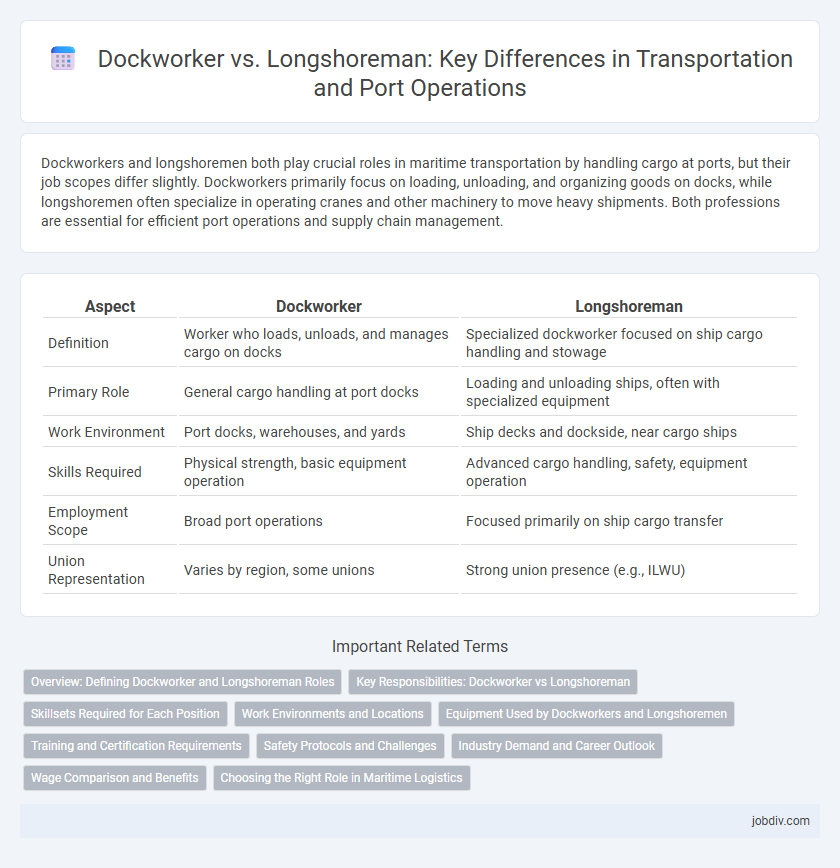Dockworkers and longshoremen both play crucial roles in maritime transportation by handling cargo at ports, but their job scopes differ slightly. Dockworkers primarily focus on loading, unloading, and organizing goods on docks, while longshoremen often specialize in operating cranes and other machinery to move heavy shipments. Both professions are essential for efficient port operations and supply chain management.
Table of Comparison
| Aspect | Dockworker | Longshoreman |
|---|---|---|
| Definition | Worker who loads, unloads, and manages cargo on docks | Specialized dockworker focused on ship cargo handling and stowage |
| Primary Role | General cargo handling at port docks | Loading and unloading ships, often with specialized equipment |
| Work Environment | Port docks, warehouses, and yards | Ship decks and dockside, near cargo ships |
| Skills Required | Physical strength, basic equipment operation | Advanced cargo handling, safety, equipment operation |
| Employment Scope | Broad port operations | Focused primarily on ship cargo transfer |
| Union Representation | Varies by region, some unions | Strong union presence (e.g., ILWU) |
Overview: Defining Dockworker and Longshoreman Roles
Dockworkers are general laborers responsible for loading, unloading, and moving cargo at ports and docks, operating a range of equipment to manage various goods. Longshoremen specialize in handling containers and heavyweight cargo on ships, often working closely with cranes and other maritime machinery to ensure efficient cargo transfer. Both roles are critical to port operations but differ in scope, with longshoremen typically having more specialized maritime-related duties.
Key Responsibilities: Dockworker vs Longshoreman
Dockworkers primarily handle the loading and unloading of cargo, securing goods on ships, and managing warehouse inventory at port docks. Longshoremen specialize in operating heavy machinery such as cranes and forklifts to move large containers, as well as coordinating logistics between ships and trucking companies. Both roles are essential for efficient maritime freight operations but differ in the scope of equipment operation and hands-on cargo management.
Skillsets Required for Each Position
Dockworkers require proficiency in operating heavy machinery such as forklifts and cranes, along with skills in cargo handling and basic repair maintenance. Longshoremen possess advanced knowledge of ship loading and unloading techniques, including securing cargo and understanding maritime safety regulations. Both roles demand physical strength, teamwork, and the ability to work under strict deadlines in a dynamic port environment.
Work Environments and Locations
Dockworkers primarily operate on docks, piers, and wharves, handling cargo loading and unloading near coastal or river ports. Longshoremen work on waterfronts and container terminals, often engaged in more specialized tasks such as container crane operation and ship stowage. Both roles require navigating dynamic, outdoor, and maritime environments with varying degrees of mechanization and safety protocols.
Equipment Used by Dockworkers and Longshoremen
Dockworkers primarily operate equipment such as forklifts, pallet jacks, and cranes for loading and unloading cargo at docks, ensuring efficient movement of goods. Longshoremen specialize in handling heavy-duty machinery including container gantry cranes, spreaders, and reach stackers, designed for managing large shipping containers. Both roles require expertise in using specialized tools to maintain seamless port operations and cargo safety.
Training and Certification Requirements
Dockworkers typically require on-the-job training focusing on equipment operation and safety protocols, with some ports mandating certification in hazardous materials handling. Longshoremen undergo extensive training programs emphasizing cargo handling, ship-to-shore coordination, and advanced safety certifications such as OSHA and TWIC cards. Both roles prioritize compliance with maritime labor standards, but longshoremen often face stricter regulatory certification to work in international shipping terminals.
Safety Protocols and Challenges
Dockworkers and longshoremen both handle cargo loading and unloading, but longshoremen often face more complex safety protocols due to operating heavy machinery and working near ship hulls. Common challenges include exposure to hazardous materials, risk of falls from heights, and the need for strict adherence to PPE (personal protective equipment) guidelines to prevent injuries. Effective communication and regular safety drills are critical to minimizing accidents in dynamic port environments.
Industry Demand and Career Outlook
Dockworkers and longshoremen both play crucial roles in the maritime shipping industry, but longshoremen typically handle cargo loading and unloading at ports, facing higher demand due to expanding global trade. The career outlook for longshoremen is strong with steady job availability driven by containerized shipping growth, while dockworker positions may vary based on port automation and mechanization trends. Industry demand favors longshoremen for their specialized skills in operating cranes and managing logistics, offering better opportunities for advancement and wage growth.
Wage Comparison and Benefits
Dockworkers typically earn a median hourly wage of $25 to $35, whereas longshoremen often receive slightly higher wages ranging from $30 to $40 per hour due to the specialized nature of their work. Benefits for both roles generally include health insurance, retirement plans, and union protections, with longshoremen unions frequently negotiating more comprehensive packages. The wage disparity reflects the longshoremen's additional responsibilities in loading and unloading ships, requiring specialized skills and certifications.
Choosing the Right Role in Maritime Logistics
Dockworkers primarily handle the loading and unloading of ships at ports, specializing in physical labor and cargo management, while longshoremen often possess additional skills in operating heavy machinery and coordinating complex logistics. Choosing the right role in maritime logistics depends on factors such as required skill level, desired responsibilities, and career growth opportunities within port operations. Understanding specific job functions and certifications, such as crane operation or hazardous material handling, helps professionals align their expertise with industry demands.
Dockworker vs Longshoreman Infographic

 jobdiv.com
jobdiv.com